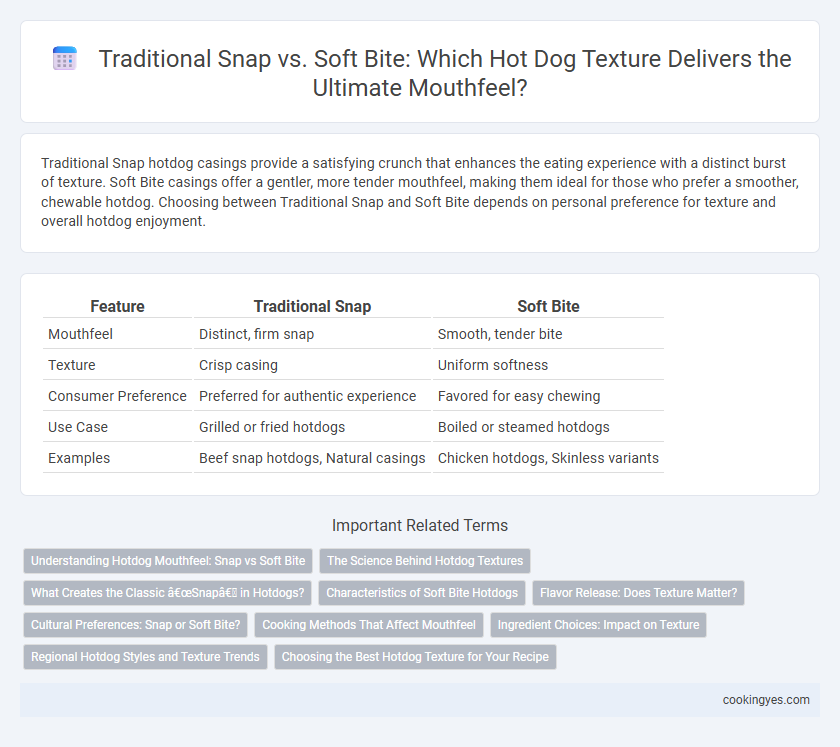Traditional Snap hotdog casings provide a satisfying crunch that enhances the eating experience with a distinct burst of texture. Soft Bite casings offer a gentler, more tender mouthfeel, making them ideal for those who prefer a smoother, chewable hotdog. Choosing between Traditional Snap and Soft Bite depends on personal preference for texture and overall hotdog enjoyment.
Table of Comparison
| Feature | Traditional Snap | Soft Bite |
|---|---|---|
| Mouthfeel | Distinct, firm snap | Smooth, tender bite |
| Texture | Crisp casing | Uniform softness |
| Consumer Preference | Preferred for authentic experience | Favored for easy chewing |
| Use Case | Grilled or fried hotdogs | Boiled or steamed hotdogs |
| Examples | Beef snap hotdogs, Natural casings | Chicken hotdogs, Skinless variants |
Understanding Hotdog Mouthfeel: Snap vs Soft Bite
Hotdog mouthfeel is defined primarily by the casing type: natural casings provide a traditional snap that offers a crisp, satisfying bite, enhancing texture and flavor perception. In contrast, soft bite hotdogs use collagen or cellulose casings, resulting in a tender, smooth texture favored in certain culinary traditions. Consumer preference for snap versus soft bite often depends on cultural influences and desired eating experience.
The Science Behind Hotdog Textures
Traditional snap hotdogs achieve their distinctive mouthfeel through natural casings made from animal intestines, which contract and rupture slightly when bitten. Soft bite hotdogs use collagen or cellulose casings, resulting in a tender, uniform texture without the snap sensation. The texture variation stems from the casing's response to heat and pressure, influencing consumer perception and preference.
What Creates the Classic “Snap” in Hotdogs?
The classic "snap" in hotdogs is created by the natural casing, typically made from cleaned sheep or hog intestines, which tightens during cooking and provides a distinct crisp texture when bitten. In contrast, hotdogs with soft bites use collagen or cellulose casings that lack this tension, resulting in a tender, uniform mouthfeel without the signature snap. Understanding the role of casing material is essential in differentiating between traditional snap and soft bite hotdogs.
Characteristics of Soft Bite Hotdogs
Soft bite hotdogs feature a tender, moist texture achieved through precise formulation and cooking techniques that retain juiciness without a resistant casing snap. This mouthfeel enhances the eating experience by providing a smooth, uniform chew that complements diverse toppings and fillings, appealing to consumers who prefer gentle, easy-to-bite proteins. The absence of a firm skin emphasizes the meat's flavor and succulence, making soft bite hotdogs ideal for those prioritizing flexibility in texture over the crispness of a traditional snap.
Flavor Release: Does Texture Matter?
Traditional snap hotdog casings create a distinctive burst of flavor by bursting open with each bite, enhancing the sensory experience and releasing oils and spices directly onto the palate. In contrast, soft bite hotdogs provide a smoother, creamier texture that allows flavors to meld gradually, offering a subtler but continuous taste release. Texture directly influences flavor perception, as the snap intensifies initial flavor impact while soft bites promote sustained flavor enjoyment.
Cultural Preferences: Snap or Soft Bite?
Cultural preferences for hotdog mouthfeel vary significantly, with many Americans favoring the traditional snap of a natural casing that delivers a satisfying crunch during each bite. In contrast, several European countries prefer hotdogs with a soft bite, emphasizing tenderness and smooth texture over crispness. These differences reflect regional tastes shaped by local culinary traditions and influence consumer expectations in hotdog production and consumption.
Cooking Methods That Affect Mouthfeel
Grilling imparts a traditional snap to hotdogs by caramelizing the casing, creating a satisfying crisp texture that contrasts with the juicy interior. Boiling or steaming results in a softer bite, as the casing remains tender and the hotdog retains more moisture. Pan-frying combines both effects by slightly crisping the surface while keeping the inside moist, balancing snap and softness.
Ingredient Choices: Impact on Texture
Traditional snap in hotdogs comes from natural casings made of collagen or animal intestines, providing a firm, crisp bite that enhances the eating experience. Soft bite textures are achieved using synthetic casings or skinless preparations, relying on emulsifiers and binders like carrageenan or soy protein to deliver a tender, cohesive mouthfeel. Ingredient choices such as fat content, protein type, and curing agents significantly influence whether the hotdog achieves a classic snap or a smooth, soft texture.
Regional Hotdog Styles and Texture Trends
Regional hotdog styles influence the preference between traditional snap and soft bite mouthfeel, with Chicago and New York favoring the iconic sausage snap for a crisp texture that contrasts with soft buns. West Coast hotdogs often embrace a softer bite, highlighting a tender, juicy experience that complements diverse toppings like avocado or spicy sauces. Texture trends reflect evolving consumer tastes, blending classic snap with innovative soft varieties to cater to broader palate preferences and dining occasions.
Choosing the Best Hotdog Texture for Your Recipe
Traditional snap hotdogs offer a firm casing that provides a satisfying pop when bitten into, enhancing the overall eating experience with a distinctive texture. Soft bite hotdogs, in contrast, deliver a tender, juicy mouthfeel that complements recipes requiring a milder texture, making them ideal for family-friendly meals or delicate toppings. Selecting the best hotdog texture depends on the desired balance between bite intensity and tenderness to perfectly match the flavor profile and culinary context of your recipe.
Traditional Snap vs Soft Bite for Hotdog Mouthfeel Infographic

 cookingyes.com
cookingyes.com